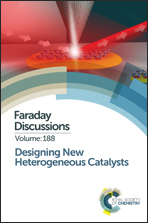New crystalline complex metal oxides created by unit-synthesis and their catalysis based on porous and redox properties†
Abstract
The development of new complex metal oxides having structural complexity suitable for solid-state catalysis is of great importance in fundamental catalysis research and practical applications. However, examples of these materials are rare. Herein, we report two types of crystalline complex metal oxides with new structures and their catalytic properties. The first one is an all-inorganic ε-Keggin polyoxometalate-based material with intrinsic microporosity. The framework of the material is formed by the assembly of ε-Keggin polyoxomolybdate units with metal ion linkers in a diamondoid topology. The micropores of the material can be opened without change of the structures, and the material adsorbs small molecules. This material has both redox properties and acidity and can be applied to O2 adsorption, selective oxidation of methacrolein, and hydrolysis of cellobiose. The other material is a crystalline metal oxide based on molecular nanowires. The hexagonal POM units stack along the c axis to form prismatic clusters as molecular wires. The molecular wires further assemble in a hexagonal fashion to form the crystals, and NH4+ and water are present in between the molecular wires. The material is active as an acid catalyst for cellobiose conversion.
- This article is part of the themed collection: Designing New Heterogeneous Catalysts

 Please wait while we load your content...
Please wait while we load your content...